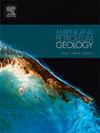四川盆地西北部上卡氏统(上三叠统)碳酸盐岩的稀土元素和钇(REY)地球化学研究
IF 3.7
2区 地球科学
Q1 GEOSCIENCES, MULTIDISCIPLINARY
引用次数: 0
摘要
稀土元素和钇(REY)是古海水地球化学性质和成岩过程的重要示踪剂。研究人员对四川盆地西北部上卡年统(上三叠统)的四种不同的碳酸盐成分--鲕粒、微波石、胶结物和腕足类--进行了稀土元素地球化学分析。岩石学和阴极发光分析被用来确定成岩特征。青羊沟(HWQ)剖面下部的亮发光微石方解石胶结物、鲕粒和微生物岩表现出钟状的 REYSN 模式。HWQ段上部的微生物岩具有相对较高的REY浓度和扁平的REYSN模式。鲕粒和微生物岩中ΣREY和土著元素(如Al、Zr、Th)的高含量反映了晚卡年四川盆地西北部土著碎屑岩的输入。研究区的铰接栉水母腕足动物总体上表现出类似现代海水的REYSN模式。不过,这种模式可能受到腕足动物壳体裂缝和点状结构中存在的疏松胶结物的影响。由于成岩蚀变和土著物质的输入,敖包虫、微波石、胶结物和腕足类不适合重建四川盆地西北部卡年海水的REY特征。本研究还强调,在利用碳酸盐成分重建REY特征时,有必要对其成岩作用和陆源污染进行全面评估。本文章由计算机程序翻译,如有差异,请以英文原文为准。
The rare earth elements and yttrium (REY) geochemistry of the upper Carnian (Upper Triassic) carbonates from northwestern Sichuan Basin (South China)
Rare earth elements and yttrium (REY) serve as valuable tracers of the geochemical properties of paleo-seawater and diagenetic processes. Four different carbonate components, ooids, microbalites, cements and brachiopods, from upper Carnian (Upper Triassic) of the northwestern Sichuan Basin were analyzed for REY geochemistry. Petrographic and cathodoluminescence analyses were employed to identify diagenetic features. The bright luminescent microspar calcite cement, ooids and the microbialites from the lower part of Qingyangou (HWQ) section exhibit bell-shaped REYSN patterns. Microbialites from the upper part of HWQ section have relatively high REY concentrations with a flat REYSN pattern. The high content of ΣREY and terrigenous elements (e.g., Al, Zr, Th) in ooids and microbialites reflect the input of terrigenous clastic in the northwestern Sichuan Basin during Late Carnian. Articulated terebratulid brachiopods in the study area display a generally modern seawater-like REYSN pattern. However, this pattern may be influenced by the presence of sparry cement that has infilled the cracks and punctae of the brachiopod shells. The ooids, microbalites, cements and brachiopods are unsuitable for reconstructing the REY characteristics of Carnian seawater in the northwestern Sichuan Basin due to diagenetic alteration and terrigenous input. This study also highlights the necessity of thoroughly evaluating carbonate components for diagenetic effects and terrigenous contamination when employing them for REY characteristic reconstruction.
求助全文
通过发布文献求助,成功后即可免费获取论文全文。
去求助
来源期刊

Marine and Petroleum Geology
地学-地球科学综合
CiteScore
8.80
自引率
14.30%
发文量
475
审稿时长
63 days
期刊介绍:
Marine and Petroleum Geology is the pre-eminent international forum for the exchange of multidisciplinary concepts, interpretations and techniques for all concerned with marine and petroleum geology in industry, government and academia. Rapid bimonthly publication allows early communications of papers or short communications to the geoscience community.
Marine and Petroleum Geology is essential reading for geologists, geophysicists and explorationists in industry, government and academia working in the following areas: marine geology; basin analysis and evaluation; organic geochemistry; reserve/resource estimation; seismic stratigraphy; thermal models of basic evolution; sedimentary geology; continental margins; geophysical interpretation; structural geology/tectonics; formation evaluation techniques; well logging.
 求助内容:
求助内容: 应助结果提醒方式:
应助结果提醒方式:


